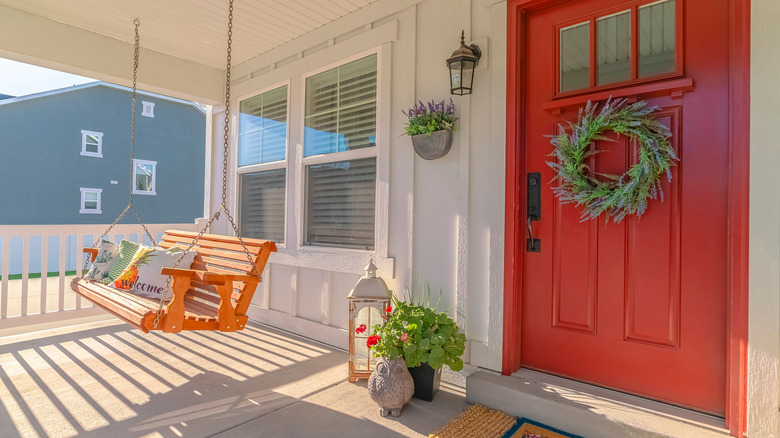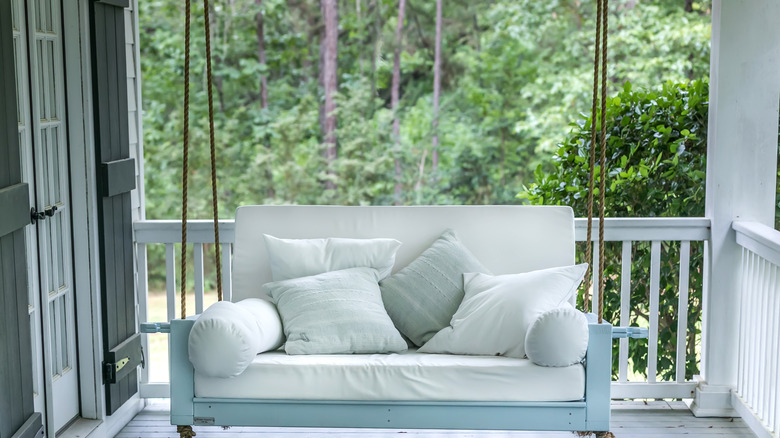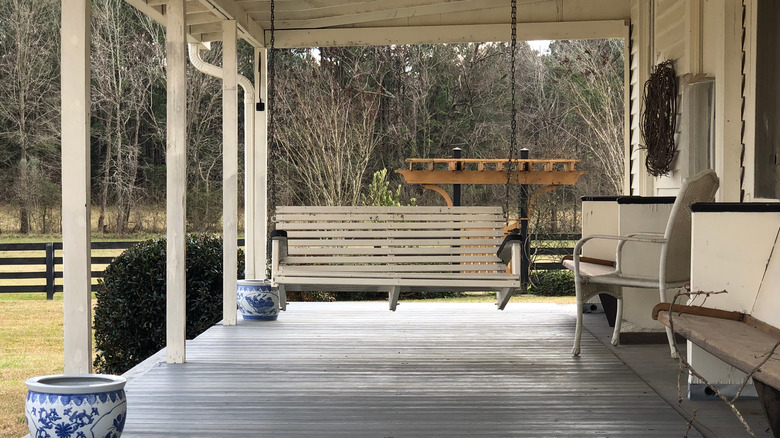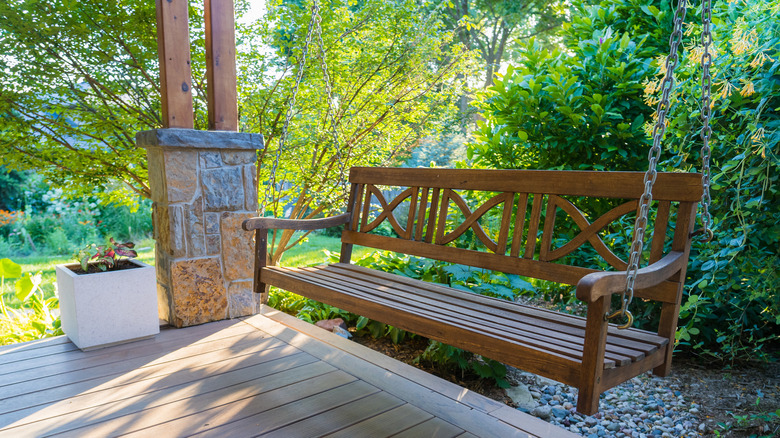How To Install A Porch Swing
A swing is a lovely addition to any front or back porch. It instantly creates a cozy, homey feel while providing a comfortable place to lounge outdoors on a warm summer afternoon with a glass of lemonade or to spend a cool evening with a cup of tea. Aside from the personal value they provide, porch swings also add curbside appeal and interest when reselling your home.
Porch swings aren't generally too expensive, either. There are many different options for different budgets. Southern Living points out that swings on the low end will range from around $150 to $400, and $1,400 to $3,500 on the high end. Many porch swings purchased from hardware or furniture stores will offer professional installation, and the fees vary depending on the company. While this is certainly a good option for most people, porch swings aren't that difficult to install. Check out the following guide for some pointers.
Choose a porch swing
Porch swings come in a variety of shapes, sizes, materials, colors, etc. This is why Home Depot recommends first and foremost to take time when deciding what kind of swing you want before anything else. They note that most traditional porch swings are made of wood, wicker, or metal. All three of these materials have different pros and cons. Wood is quite sturdy, but moisture and rain can shorten its lifespan. Wicker is attractive, but not as durable. Metal is durable and rain tolerant, but may not be as comfortable or attractive.
When thinking about a porch swing, most people imagine a two- or three-seater chair or bench-style swing. There are many more options, though, according to The Porch Swing Company. One unique option is a swing bed, which is cushioned for lounging or even sleeping outside. There are also console swings where the center of the swing folds out, providing a cupholder and tray for food. For those looking for an inexpensive and easy DIY project, consider installing a simple tree swing on your porch, made out of just a piece of wood and string. A trendier option is an egg-shaped porch swing or hammock, like this one from Wayfair.
Make sure your porch has enough structural support
Hanging porch swings can only be installed in a roofed or enclosed porch, as the ropes or supports need something to attach to. That being said, you should not install a hanging porch swing without first checking if your porch ceiling is structurally sound enough to support the weight of both the swing and the people sitting on it.
Southern Living says your porch ceiling will need to be able to support several hundred pounds to safely hold up a swing. To ensure it's strong enough, look at the beams and joists. This is easier if your porch ceiling is unfinished or exposed. Joists should preferably measure 2x8, but 2x6 is fine. If they are thinner or smaller, you'll need to add bolstering support or opt for a sitting porch swing. If your porch's ceiling is finished or covered, either remove a part of it to check the joists or try to examine the supports from above in your attic.
Purchase hanging hardware
The next step is to choose appropriate hanging hardware, which should be able to bear the weight of the swing and those using it while securely attaching to your porch ceiling. It should also seamlessly blend with the aesthetic of your front porch.
Home Depot says porch swing hardware should be able to hold at least 500 pounds. Most porch swings purchased at a store will come with hanging gear, but if you want to switch it out, or you're DIYing it, the two best options are steel chains and nylon rope. The former is sturdy, weatherproof, and durable while the latter is more visually attractive. Ropes should be at least 3/4 inch thick, and you will need just one on both ends. Steel chains require two chains for each side of the swing, so four total. You can purchase hanging kits to attach the rope or chain to, or purchase and install steel screw eyes, screw hooks, or eye bolts, along with a ring or hook. Both screws and bolts should be 1/2 inch in diameter while screws should have a minimum of a 4-inch, threaded shank.
Find ceiling joists and plan out spacing
There are two steps that are equally as important when determining where to place your porch swing — the location of the ceiling joists and making sure the swing is spaced away from walls and other porch structures. According to Plank and Pillow, installing your swing on joists is very important, as they will support the weight of the swing and its users most effectively. If you have a wooden ceiling, finding the joists can be difficult since you can't use a stud finder. You can, however, use nail holes to help determine where the joists are attached, look from above in your attic, or remove part of your ceiling, as mentioned above.
Next, you'll want to determine where to install your hanging hardware, which is ideally implemented with a screw corresponding to each hole, so four screws total. Before drilling, though, ensure your swing won't run into any obstacles. If you have a ceiling fan, for example, take care that the screws won't interfere with it. Swings should also be kept at least 2 feet away from walls or fences on all sides so they don't hit and damage your home.
Install the porch swing
Finally, it's time to install your porch swing. The first step is to install your hanging hardware in the joists you found. Home Depot recommends installing the hardware anywhere from 2 to 4 inches wider than the swing to keep the weight evenly distributed as well as to prevent the chains or ropes from rubbing against the swing itself. Drill a pre-hole smaller than the eyebolt and then put a 6-inch machine-threaded bolt through the hole and twist in, securing it with a flat washer, lock washer, and then a nut when it comes through the other side of the joist.
If your swing has the chain or rope and hooks pre-installed in the chair itself, simply attach it to the eye bolt and adjust it to your liking. If it doesn't, you'll need to install them yourself. This process depends on if you're using a rope or chain, but generally, you'll attach your material to the holes in the chair using a combination of quick hooks, S hooks, or tying knots. You'll then adjust the material to a comfortable position. If you bought your swing new, it should come with further instructions.





